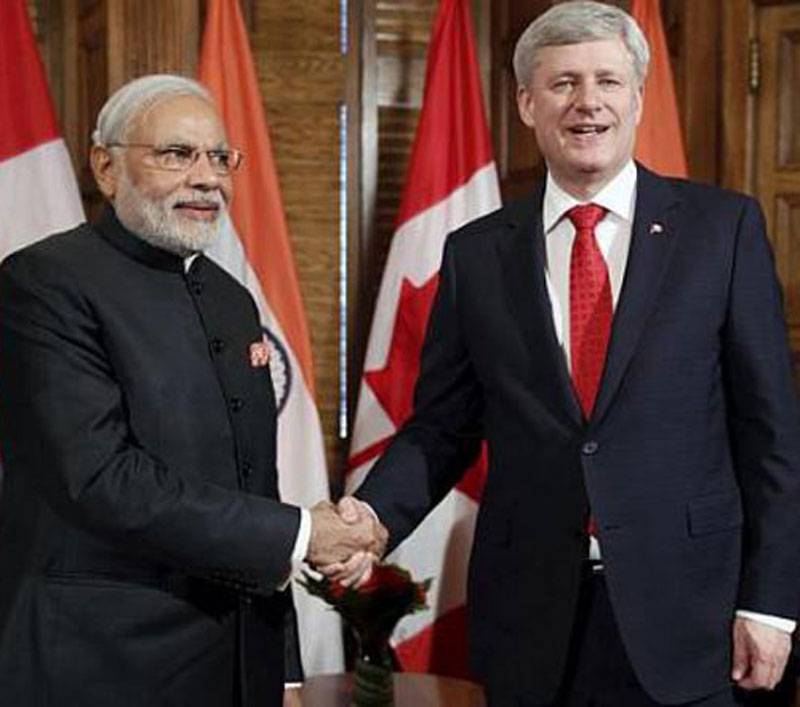OTTAWA - Canada’s prime minister announced a breakthrough deal Wednesday to supply uranium to India for electricity generation, putting behind decades of discord over India’s surreptitious use of Canadian technologies to build atomic bombs.
The agreement was signed in Ottawa during a visit by Indian Prime Minister Narendra Modi — the first Indian leader to visit Canada in 42 years, since Indira Gandhi.
The Can$350 million (US$283 million) contract is for the supply of 7.1 million pounds of uranium concentrate over the next five years, for use in a growing number of Indian nuclear power plants.
The uranium is to be sourced from the northern Saskatchewan mines of Cameco, the world’s third-largest uranium producer, accountable for 16 percent of world production. It currently exports about Can$1 billion worth of uranium annually.
Canadian Prime Minister Stephen Harper said a nuclear cooperation agreement concluded in 2012 laid the groundwork for the two Commonwealth nations “to turn the page on what had been in our judgment an unnecessarily frosty relationship for too along.” The 2012 pact signed by Harper and Modi’s predecessor, Manmohan Singh, allows Canadian companies to export nuclear materials for peaceful uses, in accordance with Canada’s nuclear non-proliferation policy. Its ratification had been delayed several years as the two nations could not agree on how to track India’s use of nuclear material to ensure it was put to peaceful purposes.
New Delhi balked at Ottawa’s demand to be allowed to monitor the safe use of its nuclear exports. In the end, the two countries agreed to set up a joint panel to supervise the exports.
New Delhi — backed by the United States — also won an exemption in 2008 from the Nuclear Suppliers Group, which governs global nuclear trade, to allow it to buy reactors and fuel from abroad — even though it has not signed the non-proliferation treaty.
India, which has tense relations with nuclear-armed rival Pakistan, had been subject to a global embargo since 1974 when it first staged an atomic weapons test.
It used plutonium from a Canadian reactor to start developing its nuclear arms program in the early 1970s.
Today, India operates 21 nuclear reactors providing 6,000 megawatts of nuclear capacity meeting about three percent of the country’s electricity needs. Another six reactors are under construction and scheduled to come online by 2017. By 2032, India expects to have 45,000 megawatts of nuclear capacity. Modi told a joint press conference with Harper that the uranium procurement deal marks “a new era of bilateral cooperation (and)... trust and confidence in India.”
“This gives the energy to our relations,” he said. The two leaders also pledged a renewed push to get stalled free trade talks back on track.
Bilateral trade is small — only Can$6.3 billion in 2014, according to Canadian government figures.
“Both Mr. Modi and I believe it could be worth much more,” Harper said. “Canada has what India needs and vice versa.”
Harper said he hoped to have a free trade deal completed by September.
However, “there are many issues to be resolved,” he added.
Modi’s visit to Canada comes after stops in France, where he ordered 36 Rafale fighter jets in a multi-billion-euro agreement, and Germany.
He is seeking to attract investors as he tries to rewrite India’s reputation as a tricky place to do business, beset by bureaucracy, corruption and a stringent tax regime.
In Canada, Modi is scheduled to visit Toronto, where he will give a keynote speech at a rock star-like coliseum event, and Vancouver.
Nearly 1.2 million Canadians trace their roots to India. South Asians are the largest visible minority in Canada.
Modi is also expected to face protesters who accuse him having encouraged deadly communal riots in 2002 in the western state of Gujarat, which he governed for over a decade.
Saturday, April 20, 2024
Canada sells uranium to India in breakthrough deal

Policitising Tragedy
April 20, 2024
Tehran to Rafah
April 20, 2024
A New Leaf
April 20, 2024
A Tense Neighbourhood
April 19, 2024
Dubai Underwater
April 19, 2024
Dangers of Deepfakes
April 20, 2024
Feudalism
April 20, 2024
Kite tragedy
April 19, 2024
Discipline dilemma
April 19, 2024
Urgent plea
April 19, 2024
ePaper - Nawaiwaqt
Advertisement
Nawaiwaqt Group | Copyright © 2024





